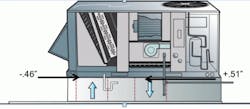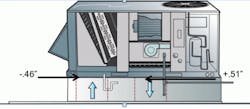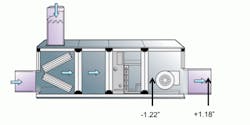Measuring Commercial Equipment Static Pressures
The fan airflow would then be plotted on the manufacturer’s fan curve as published for the fan pressure. No total external static pressure would be published or referred to in the engineering data since only the fan pressure would be used.
Be sure to check the nameplate pressure listing and the published engineering data for each piece of equipment’s pressure rating. You will still find some larger equipment rated using total external static pressure, and others using fan rated pressure.
Air Handler Accessory Pressure Drops
The pressure drop of each of the accessories (coils and filters) that are added to the air handler can then be measured and compared to the their respective pressure drops rated at the operating airflow.
Often static pressure profiles are used to report measured pressure of these commercial air handlers. A static pressure profile is a graphic illustration of the equipment and will include the location of each pressure test and the corresponding pressure reading taken at that point in the system. The pressure drop of each accessory is then calculated and shown on the pressure profile illustration.
Review Published Engineering Data
Since commercial equipment testing is more detailed and often requires increased amounts of field support, better manufacturers are beginning to see the benefits of providing improved engineering data and better tech support to ensure their equipment is installed according to their specifications and to operate as designed.
Rob “Doc” Falke serves the industry as president of National Comfort Institute an HVAC based training company and membership organization. If you're an HVAC contractor or technician interested in a detailed commercial equipment pressure testing procedure, contact Doc at [email protected] or call him at 800-633-7058. Go to NCI’s website at nationalcomfortinstitute.com for free information, articles and downloads.
About the Author
Rob 'Doc' Falke
President
Rob “Doc” Falke serves the industry as president of National Comfort Institute an HVAC-based training company and membership organization. If you're an HVAC contractor or technician interested in a building pressure measurement procedure, contact Doc at [email protected] or call him at 800-633-7058. Go to NCI’s website at NationalComfortInstitute.com for free information, articles and downloads.


